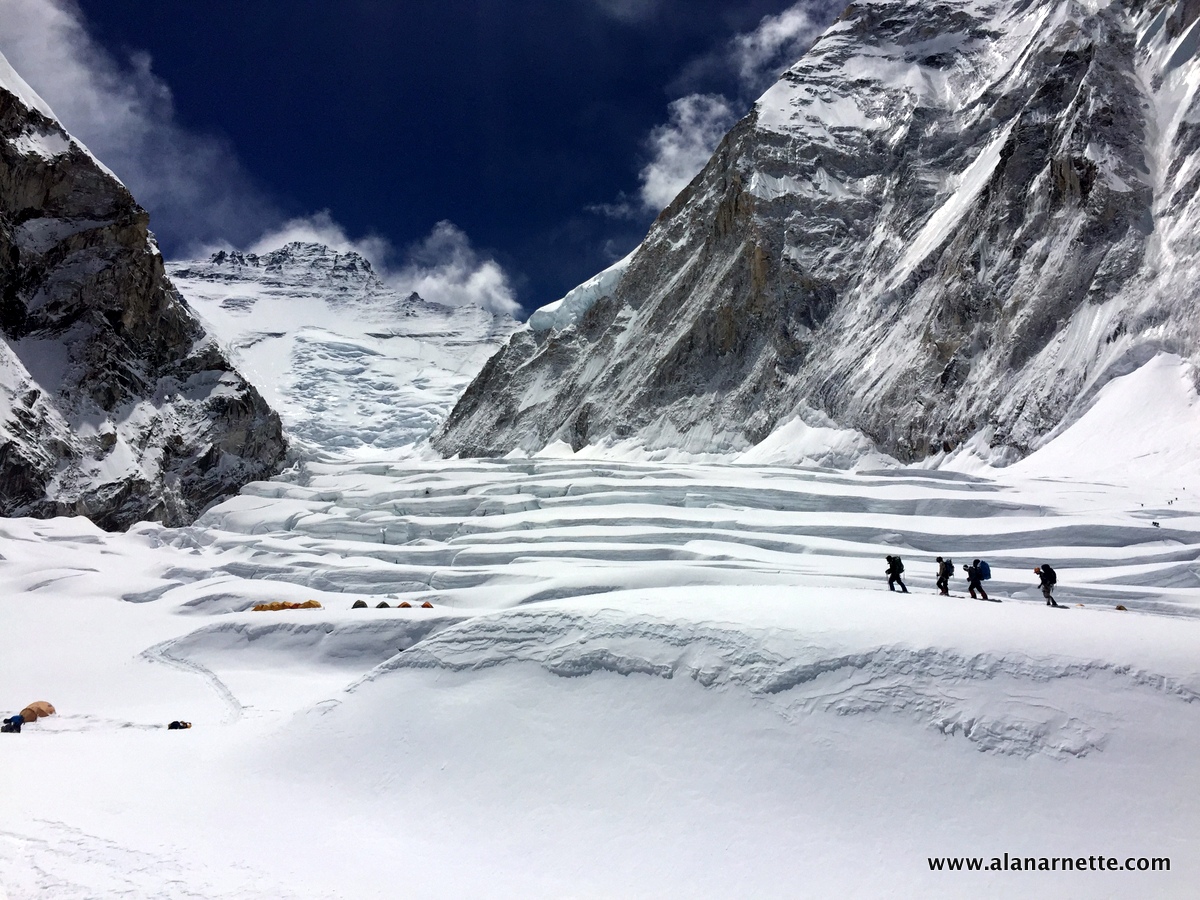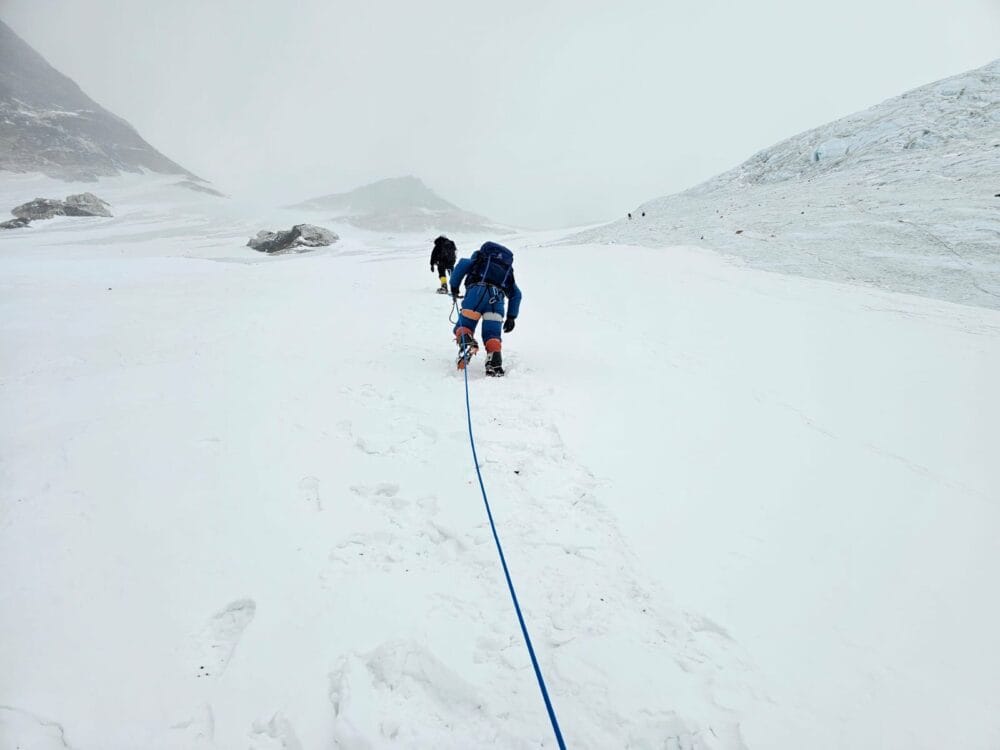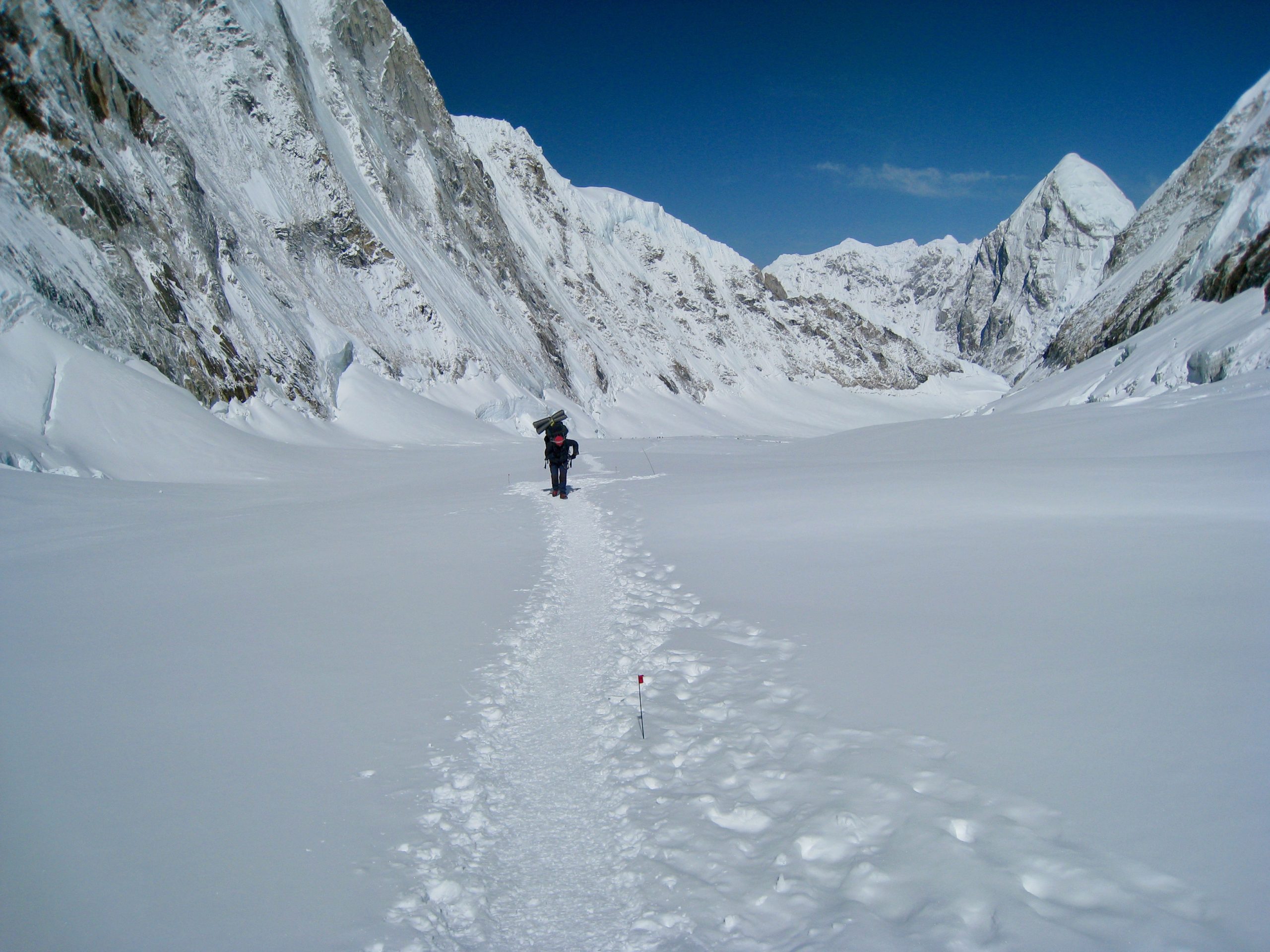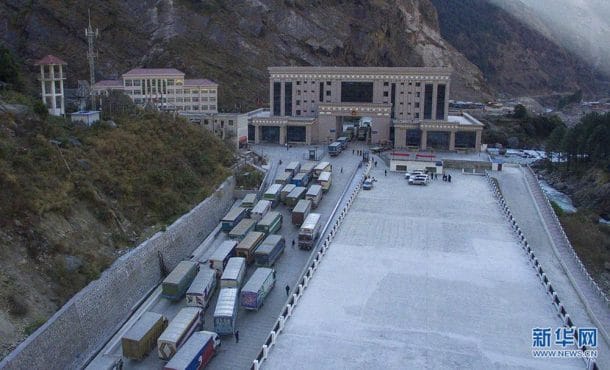Everest teams are doing the usual acclimatization rotations but are seeing heavy attrition that will ease crowding concerns. There’s a new level of base camp luxuries that might be beyond the pale for some purists. Heavy snow is forecasted on Dhaulagiri, stalling movement there. Overall, it’s been a low-drama year, thankfully.
Last Week
Last week, there was the normal mid-season activity on Everest. Teams rotated between Base Camp and Camps 1 & 2, some even tagging 3. An American climber was choppered down from C1 with a leg problem, but overall the season continues in a no-drama fashion. The internet through Everest Link had issues this past week, so the news was slowly getting out.
Speaking to people on the mountain, they report the Icefall route is long, as in nine miles measured on a Garmin watch. There are only five ladders, so it appears the Icefall Doctors choose to weave the route around crevasses to avoid ladder placement instead of going the most direct route.
I was also told that this is making it challenging for a lot of climbers. A very fit person took seven hours on his rotation to reach Camp 1, and others took as long as sixteen hours. I suspect that person will call it quits. I’m told that many teams have attrition already in the 20% range. This is about average as we near the mid-May summit widows, but for late April, it’s a bit more than usual, so we may see a 25, even 30% reduction in clients, suggesting that instead of close to 500 clients, there might be 350, which would ease potential queues.
Over the Top Base Camp Luxuries?
Several operators are continuously marketing (bragging) how great their base camp is. We are seeing reports of:
- “A certain level of comfort and luxury like western chefs, heated lounge tents, roomy member tents with real beds, a zero carbon footprint or our own team doctor are an obviousness for us. Serving you champaign is easy.” – Furtenbach Adventures
- “Our spa is fully stocked with a massage table, heater, electric blanket, relaxing music and of course our very talented massage therapist to help cure the aches and pains from upper mountain climbing exclusively for our CTSS team.” – Climbing the Seven Summits
- “‘The Residence – 8848’ tents are 20’ x 14’ and come fully equipped with a queen sized bed with electric blanket, heating, satellite TV, en suite bathroom, an entry way to store your duffels, lighting, charging, couch, table, a CTSS onesie for lounging and our famous morning drink service by our on staff barista.”- Climbing the Seven Summits
- The VIP Mt. Everest Expedition Service offered by Seven Summit Treks is an exclusive package that caters to those who wish to conquer the world’s highest mountain with a blend of adventure and luxury. This service is designed for those who want to experience the thrill of climbing Mt. Everest while enjoying the highest levels of comfort, and support. The service provides customized support, ensuring that every aspect of the expedition is tailored to meet the specific needs and preferences of the client, keeping health and safety as a top priority. – Seven Summtis Treks
I remember asking Russell Brice back in 2011 about his huge dome tent in his base camp and how he offered cappuccino and wine to his clients. I suggested that perhaps this was over the top and not real mountaineering. He grinned and said, “If you have a glass of wine at home with dinner, why not here? Just because you are climbing Everest doesn’t mean that you have to suffer.”
I also heard from Caroline Pemberton, CTSS Co owner & General Manager. She noted: “haha we like to keep raising the bar every year on climber happiness factor.”
OK, I get it, but call me old school, or just old, but to me, mountaineering is all about the three “S’s”– suffering, stinking and summiting.
Other 8000ers
Over on Shishapangma, several climbers and Sherpas claimed they made the true summit. To be candid, I don’t know any more about these claims on difficult and confusing peaks, especially for people chasing records. I don’t have a reason not to believe them adn the video looks conviencing. I just am weary of being fooled over and over. Ed Viesturs made three attempts before reaching the true summit demonstrating the challenge of the peak.
This is a video from the outfitter, Climbalaya, showing the summit:
Chinese Dong Hong Juan said she summited with two Tibetan climbers, identified by Climbalaya as Lhukdar and Thumps. She now claims she has summited all the 8000ers. Some people think she is the first female to complete the collection, given all the other females did not reach the true summits of some peaks, according to climbing community activists. Again, I have no idea and am happy for all the climbers that they feel they achieved their goal. My only concern comes from profiting from a false claim if one occurs.
Norwegian Kristin Harila, with her filmmaker Matias Myklebust, Mexican Viridiana Alvarez, and French-Swiss Sophie Lavaud, all posted pictures taken from the top. This was the first 8000er in Harila’s quest to summit off fourteen in six months. She ended up using supplemental oxygen as the climb became too difficult as she got higher. She summited twelve 8000ers last year before Chinese permit issues stopped her. She is off to Cho Oyu now. Shish was Lavaud’s thirteenth and Alvarez’s ninth (some say eighth). They were supported by Chhiring Wongchu Sherpa, Nigma Rita Sherpa, Tenjen Sherpa, and Pemba Tenjin Sherpa.
Harila’s summit came with a bit of controversy (so what doesn’t in mountaineering?) She summited Shish with Seven Summits Treks. Last year, she partnered with 8K Expeditions. The Sherpas with her last year felt snubbed when she switched operators this season. Pasdawa Sherpa, Dawa Ongju Sherpa and Dawa Ongju Sherpa wrote a scathing post on Facebook saying in part:
It greatly saddens us that in the middle of the project, after the three of us had gone through extreme hardship and had overcome the most dangerous of life-threatening situations while climbing, these 8000m giants, Kristin Harila suddenly decided to sever any ties with us. We were at a loss and often wondered about the direction of the project we worked so hard to accomplish. We wish to let everyone understand that without our genuine help and guidance from us, these 12 8000er’s would not have been possible at this record pace.
Harila responded with her explanations for the switch from 8K to Seven Summits Treks:
After Manaslu, I realized that 8K was not the right fit for me as a company for both logistical and other reasons, including not being able to help me with getting visas to Cho Oyu and Shishapangma last year. So I decided to continue the project with SST, to finish the last two mountains. Of course, I asked both Dawa and Pasdawa if they wanted to come with me. But I got no answer.“She Moves Mountains” is a NEW project, a new attempt at the 14 peaks. Despite this and rumours of Dawa and Pasdawa trying to take the record without me last year, I still invited them to join me in Tibet this year. Why? Because it would mean so much more to do it together, give them the credit they deserve.
On Dhaulagiri, there are thirty foreigners, mostly with Seven Summits treks. Colorado-based meteorologist Chris Tomer told me, “Suggested my team on Dhaulagiri descend to BC two days ago and wait out this incredibly heavy snow period. It just won’t stop. Forecasting another 2-3 feet next few days.” Carlos Soria, 84, is also on the peak attempting it for the 14th time.
Next Week
A bit of snow is in the forecast for Everest, and some teams have called for a retreat to Base Camp to wait it out. IMG gave this update:
Our weather forecaster says that unstable air still surrounds the Everest area, and the high wispy clouds and “sun dog” (22° halo) around the sun suggest that there is moisture up high in the atmosphere. Today the climbers had a nice rest day with showers and laundry on their schedules. The tentative plan is for the climbers to head back up on their Camp 3 rotation, starting on April 29. However, we are keeping a close eye on the weather, so we’ll see.
The fixed ropes to the summit were delayed a few days, but rumors around base camp have the first client summits around May 8th or 9th.
Unique
Mountain runner Killian Jornet is on Everest, keeping his plans private, but he did run, yes, run, from Namche Bazar Shep at 11,300 feet to Camp 2 at 21,000 feet. Run, Kilian, run!
Nepal RECORD Permit Update as of April 28, 2023
The permits for Everest are leveling out, albeit at a record of 466. The previous Everest record was 408 for the 2021 season of 408. Climbing permits have been issued for 1,079 climbers from 80 countries for 24 peaks. Looking at Everest only, China has the largest representation with 96 members, followed by the US at 87, India–at 40, Canada-21, Russia-20, France-13, and Australia at 12. There are 38 countries represented by three or fewer climbers.
These permits have generated $5.6M in royalties for the government. Almost all of this revenue stays in Kathmandu, with some in various personal pockets and none to the Sherpas, porters, or other high-altitude workers. The Nepal Ministry of Tourism posted these foreign permit tally as of April 28, 2022:
- Everest: 466 on 42 teams
- Ama Dablam: 74 on 7 teams
- Annapurna I: 54 on 5 teams
- Dhaulagiri: 35 on 3 teams
- Himlung: 16 on 2 teams
- Kanchenjunga: 42 on 4 teams
- Lhotse: 111 on 13 teams
- Makalu: 58 on 7 teams
- Manaslu: 15 on 4 teams
- Nuptse: 63 on 6 teams
With teams now going higher, let’s look at their first steps in the Western Cwm:
Valley of Silence
Last week, we took a few steps into the Khumbu Icefall and crossed our first ladder. Now we leave the top of the Icefall and enter the Western Cwm, also known as the “Valley of Silence.”
You’ve been going for over five hours, which is not bad for the first rotation through the dreaded Khumbu Icefall. You left Base Camp at 3:00 am with your headlamp showing the way, following Dawa like a child. Now, five hours later, the sun is poking out just above Lhotse. You stop for a moment to let this moment sink in. You remember what someone told you, “Stop and look around, especially behind, and savor what few will ever experience.
The top of the Icefall is steep as the glacier plummets from the Western Cwm and starts a 2,000-foot fall down the rocky gulley between Everest’s West Shoulder and Nuptse. It’s jumbled with house-size ice cubes as the ice breaks apart. They are scattered and random in location and don’t appear to pose a threat. However, you know one of them could shift at any moment. After all, the Icefall moves three feet a day on average, but unlike a stream, it moves in jerks, sending one of the blocks tumbling over, perhaps yards away from the fixed rope or maybe right on top. If you are in the wrong place at the wrong time, well, you don’t think about it and pick up your pace. Speed is your friend on Everest, but especially in this section.
You cross a huge crevasse. The Docs used four ladders lashed together to get across the gap. You have gained more confidence on the previous ladders, so you cross this one swiftly. The route drops down fifty feet, crosses a short section of flat ice, and then regains the lost elevation. You look up and see what you think is the top of the ‘Fall. A few more steps, and it’s confirmed. You are officially out of the Khumbu Icefall. You stop and take off your pack for some water and food. But first, you put on your sunglasses; the sun is intense. You also lather more sunscreen on your face. You start to sweat.
Your destination today is Camp 1 at 19,500 feet. The Sherpas have already set up the tents, and one is melting snow to refill your Nalgene’s. You were told Camp 1 is at the top of the Icefall, but it’s actually a bit further. You look ahead, letting your eyes inspect the horizon. “Hmm, no tents.” You start walking. The icy glacier is flat but bumpy, uneven. You hear your crampon points dig into the frozen surface, using your trekking poles for balance. You’re clipped into the fixed rope. This will be your friend, guide, and silent companion from Base Camp to the Summit and back. The rope drops out of sight. It’s a small crevasse, more like a dip. You drop down, then back up. You’re tired. “How many more of these?” you ask, not caring about an answer. You know, you just need to keep going. More dips, more heat. The Cwm is living up to its reputation.
At almost 20,000 feet, there is no shade, and the intense sunlight reflects off the ice and snow-covered faces of Nuptse, Lhotse, and Everest’s West Shoulder. There is no escape when there are no clouds. The ice-laden walls absorb any sound, thus the “Valley of Silence.” They also reflect the sun, making the Cwm insanely hot during the day and tortuously cold at night. You stop and strip down to a white nylon T-shirt. You apply sunscreen to your arms. “Ah, that’s a little better.” The wind picks up, and you feel cold. “Come on, man!” you mumble as you keep walking, now trying to stay warm. Suddenly, you spot something different up ahead. A line of tents, yes, a line of little yellow tents. They look like soldiers standing at attention, arms to their sides, hats on straight. Hmm, you might be getting carried away.
Cresting a small hill, the scene unfolds like flying out of a cloud bank. You can see everything. There are scores of tents lined up everywhere. Each team has its private enclave. Visitors are not encouraged. One of your team’s Sherpa, Passang, sees you coming and waves you over. “Long day?” he asks as you take off your pack and crawl into the yellow tent. Sitting crossed-legged, your breathing eases. Your shoulders ache a bit from carrying your pack. You glance at your watch; it’s 9:00 am. It took six hours to get here. You feel something on your face. It’s water, sweat. Glancing at the thermometer hanging off your pack strap, you’re shocked. 110F!!! Welcome to the Western Cwm.
Soon your tentmate arrives, and he reminds you to put your open sleeping bag on top of the tent to block the sun. It works; the temp drop by twenty degrees. “Great, now it’s only 90F,” you laughingly say to your mate. The day drags on. You try to sleep, but it’s too hot. Soon you are down to your underwear, wiggling your toes sticking out of the open door. The night passes, but you never go into a deep sleep. No one sleeps well at altitude, especially on the first night. When the sun went down, the temperature dropped by forty, sixty, then eighty degrees. The low was around 0F, just before dawn. You’re glad you have your -20F down sleeping bag, so you were warm. The contrast in temperatures is astounding. To experience it is brutal.
Today, you and the team will move to Camp 2 near the base of the Lhotse Face. It’s also called Advanced Base Camp, where teams have a dedicated cooking and dining tent. You’ll share a sleeping tent. The only time you have your own tent is at base camp. Remember that everything has to be carried on a Sherpa’s back for your team. Individual members carry only their personal gear. You glance around at the loads and feel guilty. You reminded yourself to thank them but, more importantly, to tip generously when the expedition ends. After a quick breakfast of oats in instant milk, the team clips back into the fixed line to begin what is said to be an “easy” walk through the Cwm. But after yesterday’s introduction, you wonder why anyone would use the term “easy” on Everest.
The route swings toward Nuptse, and the angle slightly increases. You approach 20,000 feet in altitude, your breathing increases. It’s cold as the sun is still hiding behind the massive Lhotse Face. Glancing at it, you squint to see if there are any tents set up at Camp 3, at 23,000 feet—no, nothing yet; still too early in the season. Another gaping crevasse blocks the route, but the Docs have put in more ladders, so the teams cross it one by one, each helping hold the safety line taught for the next person. The mood is relaxed as everyone gets into a rhythm. One-hour passes, then two. Hey, this was supposed to take only two hours, but you can’t see the tents at C2 yet. Wait, you see something, but then it disappears. Was it a mirage? Keep walking; you stare at the boots in front of you, knowing your teammate behind is doing the same. Suddenly you trip over your boots. Stumbling, you come to a stop looking around to see if anyone saw you. “So, you’re a climber, are you?” laughs your tentmate. You just grin, knowing he’ll make the same gymnastic move one day. “Where’s the damn camp?” you say out loud to no one.
 Camp 1 at 19,500′ in the Western Cwm
Camp 1 at 19,500′ in the Western CwmAnother half hour goes by then you see a rocky ravine to your left. Ah, the beginning of Camp 2. You’re glad because you only brought one liter of water, and it’s all gone. You are also hungry. You need more food. Thinking about your habits, you make another mental note to do a better job of self-care–hydration, nutrition, and rest. You need to be more efficient on the climb, you think, staring at the Lhotse Face. The last few steps to the gulley require scaling a small hill. Your breathing increases, and your pace slows down. How can you go much slower? You see a tent. Our camp? “Hey, is that our camp?” you call out to Dawa, who has been in front of you the whole morning. “No, ours is at the top.” He says with a slight chuckle in his voice and a sparkle in his eyes.
Climb On!
Alan
Memories are Everything
The Podcast on alanarnette.com
You can hear #everest2022 podcasts on Spotify, Apple Podcast, Google Podcasts, Pocket Casts, RadioPublic, Anchor, and more. Just search for “alan arnette” on your favorite podcast platform.
Why this coverage?
I like to use these weekend updates to remind my readers that I’m just one person who loves climbing. With 37 serious climbing expeditions, including four Everest trips under my belt and a summit in 2011, I use my site to share those experiences, demystify Everest each year and bring awareness to Alzheimer’s Disease. My mom, Ida Arnette, died from this disease in 2009, as have four of my aunts. It was a heartbreaking experience that I want no one to go through; thus, I ask for donations to non-profits where 100% goes to them and nothing ever to me.
![]()

Summit Coach
If you dream of climbing mountains but are not sure how to start or reach your next level, from a Colorado 14er to Rainier, Everest, or even K2, we can help. Summit Coach is a consulting service that helps aspiring climbers throughout the world achieve their goals through a personalized set of consulting services based on Alan Arnette’s 25 years of high-altitude mountain experience, including summits of Everest, K2, and Manaslu, and 30 years as a business executive.








6 thoughts on “Everest 2023: Weekend Update April 30”
Hi Alan,
Thanks for the update on the Everest climbing season. It’s great to hear that things are going smoothly so far, with a low number of accidents and fatalities. I’m also glad to hear that the government is generating revenue from the climbing permits, which can help to support the local economy.
I’m particularly interested in the new level of base camp luxuries that you mentioned. I’m sure some purists might find this off-putting, but I think it’s great that climbers are able to have a more comfortable experience at base camp. After all, they’re going to be spending a lot of time there, so it’s important that they’re able to rest and recover properly.
Overall, it sounds like things are going well for the Everest climbing season so far. I’m keeping my fingers crossed that it continues to be a safe and successful season for all involved.
Thanks again for the update.
Best,
Sujan Khatry
Very nice experience you shared, and the name “valley of silence” ! It’s very unique name.
Craziest news!
Kilian actually ran from Namche Bazaar to C2, which is even crazier
https://explorersweb.com/everest-kilian-jornet/
I think it won’t be long before climbers will be able to bring their lover and pet to base camp to be comfortable
Crikey – what happened? Bed tea and a small bowl of warm water seemed luxurious. Someone stole my copy of A Short Walk in the Hindu Kush which is annoying because there is a quote in that I would love to remember
Comments are closed.